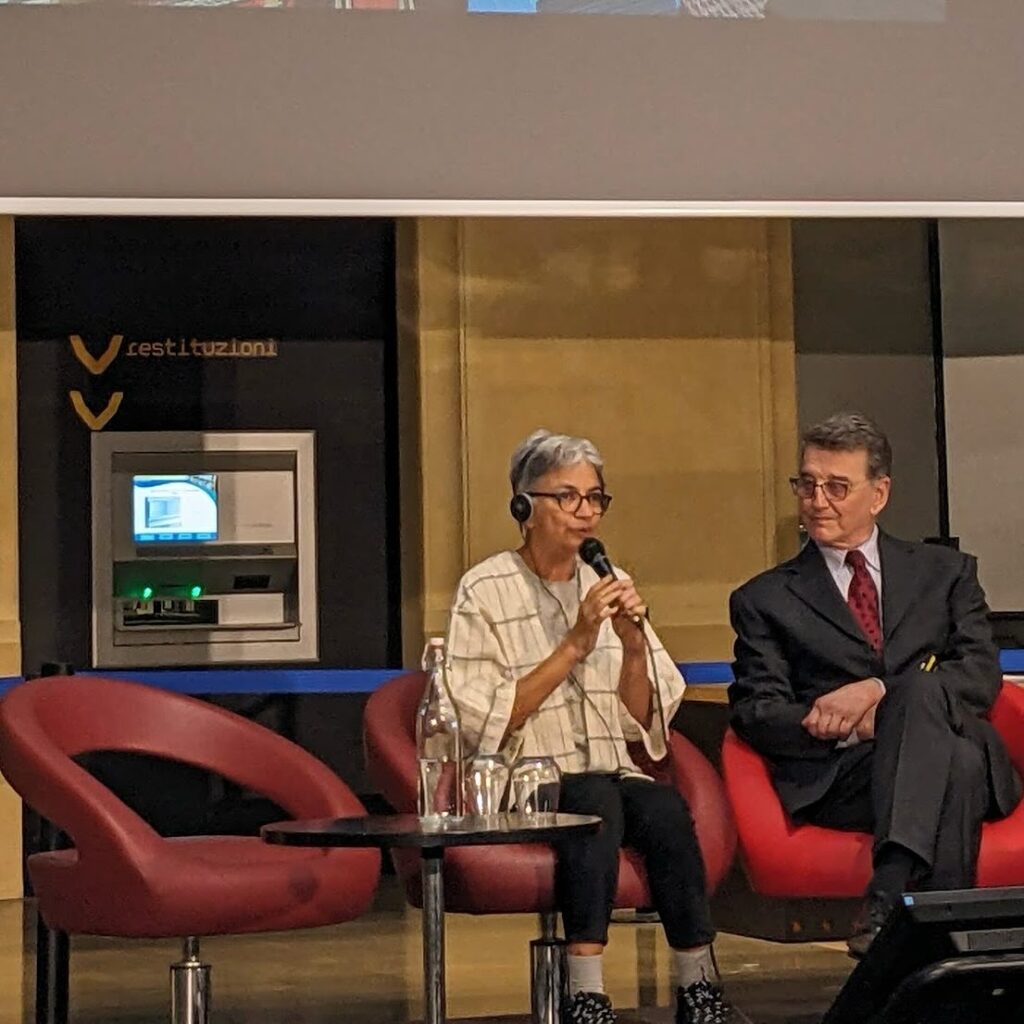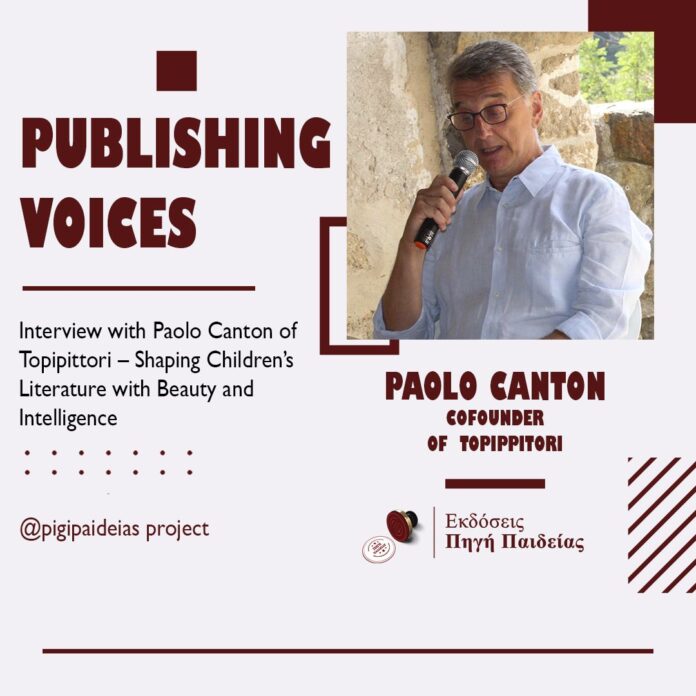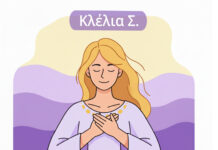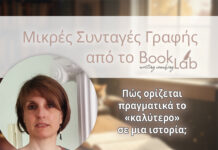When Topipittori was founded in Italy in 2004 by Paolo Canton and Giovanna Zoboli, the vision was clear yet ambitious: children’s books could be poetic, visually striking, and intellectually engaging all at once. Nearly two decades later, the independent publisher has become a reference point in Italian and European children’s literature, known for titles that respect the intelligence of young readers while offering beauty, innovation, and imagination. In this interview with Pigi Paideias’ editor Evangelia Tziaka, co-founder Paolo Canton reflects on the milestones that have shaped Topipittori, from nurturing new illustrators and authors to maintaining a distinctive visual and literary identity. He discusses the challenges and joys of independent publishing, the importance of international collaboration, and shares his hopes for connecting with creators and readers worldwide, including in Greece, highlighting the universal power of children’s literature to inspire curiosity, empathy, and wonder.

Could you introduce Topipittori to those who may not be familiar with it? What is the house’s core editorial vision?
Topipittori was created in 2004 by Giovanna Zoboli and me. The idea was to create books, picture books more specifically, which could be accepted in the international market. In order to do so, we thought it important to work with new illustrators and new authors on
innovative projects. After more than 20 years in activity, we published 370 books, 280 of them still reprinted and available in bookshops in Italy, and more than half of them published in at least one foreign language.
What distinguishes Topipittori’s approach to children’s publishing in the Italian and European market?
This is a tough question: I am not really qualified to establish what distinguishes us from our colleagues in Italy and Europe but I can tell you a few things we always try to be faithful to, which might probably contribute to the image we have in the market: we try to
respect children and their intelligence; we try to be correct in our relation with authors, illustrators, suppliers and fellow publishers; we try to stick to the idea that our work is not making books, but creating a catalogue, which is an ongoing conversation between us and
our readers.
How do you select the stories and illustrators you work with? What is the balance between text and visual narrative in your books?
The basic principle is; we only do what we like. This means we never judge a project from its commercial potential: if we love it, we are sure to find a few thousand people in the world who love it too. It is very difficult to define the balance between text and illustration in our books: the balance varies depending on the project, the qualities of texts and illustrations involved, other factors such as the graphic design and the production specifications. We always try to find this balance, which is unique to each book.
Your catalogue often emphasizes poetic, philosophical, and visually refined books. What drives that artistic direction?
Our personal taste. There isn’t anything even vaguely resembling a marketing strategy. Our choices are determined by what we think children should read, not by what we think their parents are ready to buy. Working for children, to us, means offering them beautiful things. I had a friend, a rare example of British communist, who used to say: «Nothing is too good for the working class». The same concept applies to children: nothing is too good for them, if we want to educate them to the beauty an complexity of the world they
will leave in.

What challenges do you face in maintaining a strong visual and literary identity in today’s competitive market?
The challenges we are facing have very little to do with the competitiveness of the market. Of course, there are a lot of publishers who create an enormous amount of good or very good books. But to us, this is not a challenge it is a bounty. As Hannibal the Cannibal said:«Υou desire what you see every day». And if more and more people see good, innovative books every day, it is good for us, even if those books are created, produced and sold by other companies. The real challenge is to maintain a strong visual and literary identity, which for us means always do new, innovative things, while making them recognizable as “Made in Topipittori”.
How important are international book fairs like Bologna or Frankfurt for a publisher like Topipittori, especially in terms of rights sales and collaborations?
Weren’t it for the big international book fairs, we wouldn’t have survived. Everything happens there: you sell, you buy, you get to know new people and new projects, you feel the heartbeat of the creative community that keeps publishing alive. But I would also specify that it is not just the BIG International book fairs: in smaller, regional events (and especially through fellowship programs) you benefit of a more relaxed time, you get to know in depth the specific market, you create new relations and consolidate old ones.
What are some of your most successful or surprising international rights sales in recent years?
La Zuppa Lepron, by Giovanna Zoboli and Mariachiara Di Giorgio is an anti-capitalistic cautionary tale, has been sold in 21 languages in the last five years. But we pride ourself to have published also Che cos’è un bambino? By Beatrice Alemagna, in Italian bookshops since 2008, it sold more than 100.000 copies and has been translated into 22 languages.
Are you actively looking to collaborate with authors or illustrators from outside Italy, including countries like Greece?
We always do. Since the very beginning we looked for talents anywhere, from Italy to Iran, from France to Japan, from Germany to Uruguay or Colombia. We never had the chance to collaborate with Greek creators, though.
What advice would you give to new publishers or editors who want to focus on high-quality children’s literature?
Learn form the past. Trust your principles and ideas. Go global. Never forget who you are and where you come from.
How has the readership of children’s books changed over the years in Italy? What are young readers (and their parents) looking for today?
I have no idea of what young readers and their parents are looking for. And, if we had a magic wand, we wouldn’t use it for predicting the future. As I said above, publish books we think children should read, not those we think their parents are ready to buy. But there is something I would love to talk about: how different the present is from the recent past. Twenty years ago, in Italy, there wasn’t a market for picture books. Now, thanks to the efforts of a few small, independent publishers, a group of devoted booksellers, librarians and parents (I should say “mothers”) who actively created a strong movement for the development and the consolidation of a picture book culture in our country, more and more people know, appreciate, buy and use picture books. So this new market stemmed out of the basic need of people to offer better books to their children. This is making more and more difficult for publishers to create innovative, surprising books. But,
nonetheless, it makes our work happier, because we know we do not need to struggle to make our books understood and accepted.

What role does independent publishing play in shaping the future of children’s literature?
Usually, independent publishers are the engine of progress. It is with independent publishers that you can find new forms, new ideas, new authors and illustrators, new design. By being innovative, independent publishers bear the biggest part of the risk involved in – as you say – shaping the future of children’s literature. By being innovative, they fail all too often, but sometimes they succeed in giving shape to that something booksellers, librarians, children (and their adults) were looking for, but hadn’t yet found.
Looking ahead, what are your hopes for Topipittori’s presence in the international publishing scene?
After more than twenty years in publishing, we think we can say we are an “establishment”. So, the best hopes we may have is to keep on innovating the contents of our books, finding new ways and tools to reach our customer, strengthen the collaboration with colleagues worldwide. It will not be easy, as we are growing old, we will need new energies and resources. But we will do our best to try and do it.
Paolo Canton’s insights into Topipittori reveal a publishing house guided by curiosity, beauty, and respect for young readers’ intelligence. From nurturing new talent to maintaining a distinctive visual and literary identity, his reflections highlight the dedication, innovation, and collaborative spirit that have shaped two decades of remarkable children’s literature. We sincerely thank Paolo Canton for sharing his time and experiences, offering a rare glimpse into the heart and vision of Topipittori.
Ακολουθεί η ελληνική μετάφραση
Συνέντευξη με τον Paolo Canton των Εκδόσεων Topipittori – Όταν η παιδική λογοτεχνία συναντά την ομορφιά και τη σκέψη
Όταν ο εκδοτικός οίκος Topipittori ιδρύθηκε στην Ιταλία το 2004 από τον Paolo Canton και τη Giovanna Zoboli, το όραμα ήταν σαφές αλλά φιλόδοξο: τα παιδικά βιβλία μπορούν να είναι ποιητικά, οπτικά εντυπωσιακά και πνευματικά απαιτητικά ταυτόχρονα. Σχεδόν δύο δεκαετίες αργότερα, ο ανεξάρτητος αυτός εκδότης έχει γίνει σημείο αναφοράς στην ιταλική και ευρωπαϊκή παιδική λογοτεχνία, γνωστός για τίτλους που σέβονται τη νοημοσύνη των παιδιών-αναγνωστών, ενώ παράλληλα προσφέρουν ομορφιά, καινοτομία και φαντασία.
Στη συνέντευξη που ακολουθεί με τη συντάκτρια του Πηγή Παιδείας Ευαγγελία Τζιάκα, ο συνιδρυτής Paolo Canton ανατρέχει στα ορόσημα που διαμόρφωσαν τον εκδοτικό οίκο Topipittori — από την καλλιέργεια νέων εικονογράφων και συγγραφέων έως τη διατήρηση μιας διακριτής οπτικής και λογοτεχνικής ταυτότητας. Μιλά για τις προκλήσεις και τις χαρές της ανεξάρτητης έκδοσης, τη σημασία της διεθνούς συνεργασίας και εκφράζει την ελπίδα του να συνδεθεί με δημιουργούς και αναγνώστες σε όλο τον κόσμο — και στην Ελλάδα — αναδεικνύοντας τη διαχρονική δύναμη της παιδικής λογοτεχνίας να εμπνέει περιέργεια, ενσυναίσθηση και θαυμασμό.
Θα μπορούσατε να μας συστήσετε τον εκδοτικό οίκο Topipittori; Ποιο είναι το βασικό εκδοτικό σας όραμα;
Ο Topipittori δημιουργήθηκε το 2004 από εμένα και τη Giovanna Zoboli. Η ιδέα μας ήταν να φτιάχνουμε βιβλία —εικονογραφημένα βιβλία ειδικότερα— που θα μπορούσαν να σταθούν στην παγκόσμια αγορά. Για να το πετύχουμε, θεωρήσαμε σημαντικό να συνεργαστούμε με νέους εικονογράφους και συγγραφείς πάνω σε καινοτόμα έργα. Ύστερα από περισσότερα από 20 χρόνια δραστηριότητας, έχουμε εκδώσει 370 βιβλία, εκ των οποίων 280 εξακολουθούν να επανεκδίδονται και να είναι διαθέσιμα στα ιταλικά βιβλιοπωλεία, ενώ περισσότερα από τα μισά έχουν μεταφραστεί τουλάχιστον σε μία ξένη γλώσσα.
Τι ξεχωρίζει την προσέγγιση του Topipittori στην ιταλική και ευρωπαϊκή αγορά παιδικού βιβλίου;
Είναι δύσκολη ερώτηση, γιατί δεν θεωρώ ότι είμαι ο πιο κατάλληλος να πω τι μας ξεχωρίζει. Μπορώ όμως να αναφέρω μερικές αρχές που ακολουθούμε πιστά: προσπαθούμε να σεβόμαστε τα παιδιά και τη νοημοσύνη τους, να είμαστε δίκαιοι στις σχέσεις μας με συγγραφείς, εικονογράφους, προμηθευτές και άλλους εκδότες και να θυμόμαστε ότι η δουλειά μας δεν είναι απλώς να εκδίδουμε βιβλία, αλλά να δημιουργούμε έναν κατάλογο —μια συνεχή συνομιλία μεταξύ εμάς και των αναγνωστών μας.
Πώς επιλέγετε τις ιστορίες και τους εικονογράφους με τους οποίους συνεργάζεστε; Πώς ισορροπείτε ανάμεσα στο κείμενο και την εικονογράφηση;
Η βασική μας αρχή είναι απλή: κάνουμε μόνο ό,τι μας αρέσει. Δεν αξιολογούμε ένα έργο με βάση τη δυνητική του εμπορική επιτυχία· αν μας συγκινεί, είμαστε βέβαιοι πως θα υπάρξουν μερικές χιλιάδες άνθρωποι στον κόσμο που θα το αγαπήσουν επίσης. Η ισορροπία ανάμεσα σε κείμενο και εικόνα ποικίλλει από βιβλίο σε βιβλίο — εξαρτάται από το ύφος του κειμένου, το ύφος της εικονογράφησης, τον σχεδιασμό και τις εκδοτικές προδιαγραφές. Προσπαθούμε πάντα να βρούμε τη μοναδική ισορροπία που ταιριάζει σε κάθε έργο.
Ο κατάλογός σας έχει έντονο καλλιτεχνικό, φιλοσοφικό και ποιητικό χαρακτήρα. Τι καθοδηγεί αυτή την κατεύθυνση;
Το προσωπικό μας γούστο. Δεν υπάρχει τίποτα που να θυμίζει στρατηγική μάρκετινγκ. Οι επιλογές μας καθορίζονται από αυτό που πιστεύουμε ότι τα παιδιά αξίζει να διαβάζουν, όχι από αυτό που θεωρούμε ότι οι γονείς είναι έτοιμοι να αγοράσουν. Για εμάς, το να δουλεύεις για παιδιά σημαίνει να τους προσφέρεις το ωραίο. Είχα έναν φίλο, έναν σπάνιο Βρετανό κομμουνιστή, που έλεγε: «Τίποτα δεν είναι υπερβολικά καλό για την εργατική τάξη». Το ίδιο ισχύει για τα παιδιά· τίποτα δεν είναι υπερβολικά καλό για εκείνα, αν θέλουμε να τα μάθουμε να αναγνωρίζουν την ομορφιά και την πολυπλοκότητα του κόσμου όπου θα ζήσουν.
Ποιες είναι οι προκλήσεις για τη διατήρηση μιας ισχυρής οπτικής και λογοτεχνικής ταυτότητας σήμερα;
Οι προκλήσεις μας δεν σχετίζονται τόσο με τον ανταγωνισμό. Υπάρχουν πολλοί εκδότες που κάνουν εξαιρετικά βιβλία —και αυτό το θεωρούμε πλούτο, όχι απειλή. Όπως είπε ο Χάνιμπαλ ο Ανθρωποφάγος: «Επιθυμείς αυτό που βλέπεις κάθε μέρα». Αν, λοιπόν, όλο και περισσότεροι άνθρωποι βλέπουν καλά, πρωτότυπα βιβλία, αυτό μόνο καλό μπορεί να είναι — ακόμη κι αν δεν είναι δικά μας. Η πραγματική πρόκληση είναι να διατηρούμε μια ταυτότητα Topipittori, κάνοντας πάντα κάτι καινούριο και καινοτόμο, αλλά αναγνωρίσιμο.
Πόσο σημαντικές είναι οι διεθνείς εκθέσεις βιβλίου όπως η Μπολόνια ή η Φρανκφούρτη;
Αν δεν υπήρχαν οι μεγάλες διεθνείς εκθέσεις, πιθανότατα δεν θα είχαμε επιβιώσει. Εκεί συμβαίνουν όλα: πωλήσεις, αγορές, γνωριμίες, ανταλλαγές ιδεών. Είναι η καρδιά της δημιουργικής κοινότητας που κρατά το βιβλίο ζωντανό. Αλλά δεν είναι μόνο οι μεγάλες εκθέσεις — και οι μικρότερες, περιφερειακές εκδηλώσεις, ειδικά μέσω προγραμμάτων φιλοξενίας, προσφέρουν πιο χαλαρό χρόνο για ουσιαστικές γνωριμίες και συνεργασίες.
Ποιοι τίτλοι σας είχαν τη μεγαλύτερη διεθνή επιτυχία;
Το La Zuppa Lepron της Giovanna Zoboli και της Mariachiara Di Giorgio —μια αντικαπιταλιστική αλληγορία— έχει πουληθεί σε 21 γλώσσες μέσα σε πέντε χρόνια.
Επίσης, το Che cos’è un bambino? της Beatrice Alemagna, που κυκλοφορεί στην Ιταλία από το 2008, έχει πουλήσει πάνω από 100.000 αντίτυπα και έχει μεταφραστεί σε 22 γλώσσες.
Αναζητάτε συνεργασίες με δημιουργούς εκτός Ιταλίας, όπως από την Ελλάδα;
Πάντα το κάνουμε. Από την αρχή ψάχνουμε ταλέντα σε όλο τον κόσμο — από την Ιταλία ως το Ιράν, τη Γαλλία, την Ιαπωνία, τη Γερμανία, την Ουρουγουάη ή την Κολομβία.Ωστόσο, δεν είχαμε ακόμα την ευκαιρία να συνεργαστούμε με Έλληνες δημιουργούς.
Τι θα συμβουλεύατε νέους εκδότες ή επιμελητές που θέλουν να εστιάσουν στην ποιοτική παιδική λογοτεχνία;
Να μαθαίνουν από το παρελθόν, να εμπιστεύονται τις αρχές και τις ιδέες τους, να σκέφτονται παγκόσμια, αλλά να μην ξεχνούν ποτέ ποιοι είναι και από πού έρχονται.
Πώς έχει αλλάξει το κοινό του παιδικού βιβλίου στην Ιταλία τα τελευταία χρόνια;
Δεν ξέρω τι ψάχνουν τα παιδιά και οι γονείς τους — και, ακόμη κι αν είχαμε μαγικό ραβδί, δεν θα το χρησιμοποιούσαμε για να προβλέψουμε το μέλλον.
Όπως είπα, εκδίδουμε βιβλία που πιστεύουμε ότι πρέπει να διαβάζουν τα παιδιά, όχι αυτά που νομίζουμε ότι οι γονείς θέλουν να αγοράσουν.
Αυτό που μπορώ να πω είναι πως, πριν από 20 χρόνια, στην Ιταλία δεν υπήρχε πραγματική αγορά για εικονοβιβλία.
Σήμερα, χάρη στην προσπάθεια ανεξάρτητων εκδοτών, βιβλιοπωλών, βιβλιοθηκονόμων και γονιών (κυρίως μητέρων), έχει δημιουργηθεί μια δυνατή κουλτούρα εικονοβιβλίου στη χώρα.
Αυτό δυσκολεύει τη δημιουργία πρωτότυπων βιβλίων, αλλά κάνει τη δουλειά μας πιο ευχάριστη — γιατί πια δεν χρειάζεται να παλεύουμε για να κατανοηθούμε.
Τι ρόλο παίζουν οι ανεξάρτητοι εκδότες στο μέλλον της παιδικής λογοτεχνίας;
Συνήθως, οι ανεξάρτητοι εκδότες είναι η κινητήρια δύναμη της προόδου.
Μαζί τους συναντάς νέες μορφές, νέες ιδέες, νέους δημιουργούς, νέα σχεδίαση.
Αναλαμβάνοντας το ρίσκο της καινοτομίας, συχνά αποτυγχάνουν — αλλά κάποιες φορές καταφέρνουν να δημιουργήσουν αυτό ακριβώς που έψαχναν οι βιβλιοπώλες, οι βιβλιοθηκονόμοι και τα παιδιά, χωρίς να το ξέρουν ακόμα.
Ποιο είναι το όραμά σας για τη διεθνή παρουσία του Topipittori τα επόμενα χρόνια;
Ύστερα από πάνω από 20 χρόνια, μπορούμε να πούμε πως είμαστε πια “θεσμός”.
Η ελπίδα μας είναι να συνεχίσουμε να καινοτομούμε στο περιεχόμενο, να ανακαλύπτουμε νέους τρόπους επικοινωνίας με το κοινό, να ενισχύουμε τις διεθνείς συνεργασίες.
Δεν θα είναι εύκολο — μεγαλώνουμε, και θα χρειαστούμε νέες δυνάμεις και πόρους — αλλά θα προσπαθήσουμε.
Οι σκέψεις του Paolo Canton αποκαλύπτουν έναν εκδοτικό οίκο που καθοδηγείται από την περιέργεια, την ομορφιά και τον σεβασμό στη νοημοσύνη των παιδιών.
Από την καλλιέργεια νέων ταλέντων έως τη διατήρηση μιας μοναδικής αισθητικής και λογοτεχνικής ταυτότητας, η πορεία του Topipittori αντικατοπτρίζει αφοσίωση, καινοτομία και πνεύμα συνεργασίας.
Τον ευχαριστούμε θερμά για τον χρόνο και τις σκέψεις του, που μας προσέφεραν μια σπάνια ματιά στην καρδιά και το όραμα ενός από τους πιο ξεχωριστούς εκδοτικούς οίκους της Ευρώπης.










